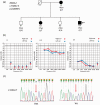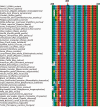A novel variant in DMXL2 gene is associated with autosomal dominant non-syndromic hearing impairment (DFNA71) in a Cameroonian family
- PMID: 33715530
- PMCID: PMC8283254
- DOI: 10.1177/1535370221999746
A novel variant in DMXL2 gene is associated with autosomal dominant non-syndromic hearing impairment (DFNA71) in a Cameroonian family
Erratum in
-
Corrigendum to A novel variant in DXML2 gene is associated with autosomal dominant non-syndromic hearing impairment (DFNA71) in a Cameroonian family.Exp Biol Med (Maywood). 2021 Nov;246(21):NP5. doi: 10.1177/15353702211040362. Exp Biol Med (Maywood). 2021. PMID: 34749523 Free PMC article. No abstract available.
Abstract
Approximately half of congenital hearing impairment cases are inherited, with non-syndromic hearing impairment (NSHI) being the most frequent clinical entity of genetic hearing impairment cases. A family from Cameroon with NSHI was investigated by performing exome sequencing using DNA samples obtained from three family members, followed by direct Sanger sequencing in additional family members and controls participants. We identified an autosomal dominantly inherited novel missense variant [NM_001174116.2:c.918G>T; p.(Q306H)] in DMXL2 gene (MIM:612186) that co-segregates with mild to profound non-syndromic sensorineural hearing impairment . The p.(Q306H) variant which substitutes a highly conserved glutamine residue is predicted deleterious by various bioinformatics tools and is absent from several genome databases. This variant was also neither found in 121 apparently healthy controls without a family history of hearing impairment , nor 112 sporadic NSHI cases from Cameroon. There is one previous report of a large Han Chinese NSHI family that segregates a missense variant in DMXL2. The present study provides additional evidence that DMXL2 is involved in hearing impairment etiology, and we suggest DMXL2 should be considered in diagnostic hearing impairment panels.
Keywords: Africa; DMXL2; Non-syndromic hearing impairment; autosomal dominant inheritance.
Conflict of interest statement
Figures



Similar articles
-
Bi-Allelic Novel Variants in CLIC5 Identified in a Cameroonian Multiplex Family with Non-Syndromic Hearing Impairment.Genes (Basel). 2020 Oct 23;11(11):1249. doi: 10.3390/genes11111249. Genes (Basel). 2020. PMID: 33114113 Free PMC article.
-
A dominant variant in DMXL2 is linked to nonsyndromic hearing loss.Genet Med. 2017 May;19(5):553-558. doi: 10.1038/gim.2016.142. Epub 2016 Sep 22. Genet Med. 2017. PMID: 27657680
-
A novel variant c.902C>A (p. A301D) in KCNQ4 associated with non-syndromic deafness 2A in a Chinese family.Mol Genet Genomic Med. 2024 Jul;12(7):e2446. doi: 10.1002/mgg3.2446. Mol Genet Genomic Med. 2024. PMID: 38980994 Free PMC article.
-
[From gene to disease; non-syndromic, autosomal dominant, low-frequency sensorineural hearing loss (DFNA6/14)].Ned Tijdschr Geneeskd. 2003 Nov 1;147(44):2170-2. Ned Tijdschr Geneeskd. 2003. PMID: 14626834 Review. Dutch.
-
MYO15A splicing mutations in hearing loss: A review literature and report of a novel mutation.Int J Pediatr Otorhinolaryngol. 2017 May;96:35-38. doi: 10.1016/j.ijporl.2017.03.008. Epub 2017 Mar 6. Int J Pediatr Otorhinolaryngol. 2017. PMID: 28390610 Review.
Cited by
-
Hearing loss in Africa: current genetic profile.Hum Genet. 2022 Apr;141(3-4):505-517. doi: 10.1007/s00439-021-02376-y. Epub 2021 Oct 5. Hum Genet. 2022. PMID: 34609590 Free PMC article. Review.
-
Rabconnectin-3α/DMXL2 Is Locally Enriched at the Synaptic Ribbon of Rod Photoreceptor Synapses.Cells. 2023 Jun 19;12(12):1665. doi: 10.3390/cells12121665. Cells. 2023. PMID: 37371135 Free PMC article.
-
Short- and long-term effects of radiation exposure at low dose and low dose rate in normal human VH10 fibroblasts.Front Public Health. 2023 Dec 15;11:1297942. doi: 10.3389/fpubh.2023.1297942. eCollection 2023. Front Public Health. 2023. PMID: 38162630 Free PMC article.
-
Etiologies of Childhood Hearing Impairment in Schools for the Deaf in Mali.Front Pediatr. 2021 Nov 29;9:726776. doi: 10.3389/fped.2021.726776. eCollection 2021. Front Pediatr. 2021. PMID: 34912757 Free PMC article.
-
Autosomal Dominant Non-Syndromic Hearing Loss (DFNA): A Comprehensive Narrative Review.Biomedicines. 2023 Jun 1;11(6):1616. doi: 10.3390/biomedicines11061616. Biomedicines. 2023. PMID: 37371710 Free PMC article. Review.
References
-
- Shearer AE, Hildebrand MS, Smith RJH. Hereditary hearing loss and deafness overview. In: Adam MP, Ardinger HH, Pagon RA, Wallace SE, Bean LJH, Stephens K, Amemiya A (eds) GeneReviews®. Seattle (WA): University of Washington, Seattle, 1993. - PubMed
Publication types
MeSH terms
Substances
Grants and funding
LinkOut - more resources
Full Text Sources
Other Literature Sources
Molecular Biology Databases

